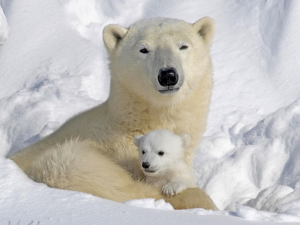News
Latest Lion Aid News
CITES Travesty Part 3: Polar Bears
Friday 22nd February 2013
|
The USA together with the Russian Federation have put a proposal to the CITES Conference of Parties to uplist polar bears (Ursus maritimus) from Appendix II to Appendix I. The proposal considered that this higher level of protection was needed as polar bears, in addition to being threatened in the future by the increasing loss of ice in the Arctic (summer ice has decreased by 15-20% due to climate change) also are significantly affected by trade. Indeed, the USA proposal mentions that from 2001-2010 something like 6798 polar bear products were traded, including skins, skulls, trophies, “bodies” and live animals. 79% of the trade emanates from Canada. Polar bears seem to be a forthcoming “hot issue” at the CITES Conference of Parties. Why is LionAid concerned with polar bears? We are following this proposal closely for several reasons. First, with a remaining population of perhaps 20,000 animals it resembles the number of African lions remaining in the world. Second, the number of sport hunting polar bear trophies and skins exported are roughly similar to trade in similar products from lions, and the USA polar bear proposal could therefore be a test of whether such trade can be considered by CITES as having a negative effect on populations. Third, polar bear and lion populations are only estimated rather than known, yet such estimates are considered sufficient information by CITES to allow a harvest of trophies and skins. Fourth, the polar bear uplisting proposal is based on a very important (but little used) concept that should guide many CITES decisions – the precautionary principle – that basically means that one should always err on the side of caution when allowing commercial offtake of any species where the long-term effects of such offtake are not adequately known. So back to polar bear issues. Their arctic range has been divided into 19 recognized populations. Of those, one is deemed to be increasing in numbers, three are stable, eight are decreasing and seven are unknown/data deficient. For some populations, assessments are only made every 10-15 years. For one Russian population, several hundred bears are estimated to be poached per year for their skins. Of the range states, Canada, Russia and USA allow “subsistence” hunting of polar bears by indigenous communities. Canada additionally allows sport hunting by non-natives and non-citizens by facilitating the indigenous communities to sell their quotas to hunters. The USA declared polar bears protected under their Endangered Species Act in 2008, meaning that no polar bear products can be commercially traded within the USA. Polar bear commercial hunting has been banned in Russia since 1956, and Greenland currently enforces a moratorium on polar bear offtake after a 2008 report indicating a detrimental effect on polar bear populations. Norway allows no offtake from her single population of polar bears in Svalbard. Canada is thus the single nation among polar bear range states allowing international commercial offtake. Looking at the official CITES records of exports from Canada there are some interesting trends in the trade. For example, from 2006-2008 Japan imported 913 skins. From 2007-2011 China imported 420 skins. From 2009-2011 China imported 142 polar bear trophies from Canada. Norway, having banned any offtake from “their” polar bears, allowed imports of 349 skins from Canada 2001-2010. It is estimated that a polar bear skin these days sells between $4000 - $8000. Polar bears came on the CITES uplisting agenda in 2010. It was then defeated, primarily due to European Union swing votes. The CITES Secretariat, perhaps exceeding their mandate, has now advised Parties to again vote against the uplisting at CoP16. We already know that votes against will come from Norway and Denmark (adequate protection measures already in place) and Canada (profitable trade for the local communities regardless of impact on polar bear conservation). Russia and the USA will vote for the uplisting and so will some EU nations. Others, like the UK, are sitting on the fence for no scientifically valid reason. Conservation organizations like the WWF have already come out against uplisting – while appealing for polar bear conservation donations. On our part, we would encourage all CITES member states to vote positively to place polar bears on CITES Appendix I. And once the trade is stopped, to do a careful analysis of remaining polar bear populations given that their habitat is melting away as you read this message. Picture credit: www.pelauts.com Please support us if you can to conserve the remaining fragile lion populations. Thank you. Tags: CITES, Illegal wildlife trade, USA, Canada, polar bears, Russian Federation, Categories: Illegal Wildlife Trade |
Posted by Pieter Kat at 16:01
No comments have been posted yet.
Add a new comment
Existing user
New user sign up




